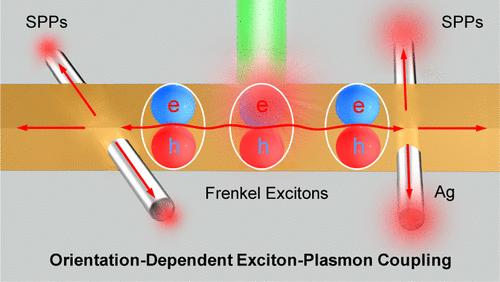Our official English website, www.x-mol.net, welcomes your
feedback! (Note: you will need to create a separate account there.)
Orientation-Dependent Exciton–Plasmon Coupling in Embedded Organic/Metal Nanowire Heterostructures
ACS Nano ( IF 15.8 ) Pub Date : 2017-09-22 00:00:00 , DOI: 10.1021/acsnano.7b04584 Yong Jun Li 1 , Yan Hong 2 , Qian Peng , Jiannian Yao 1 , Yong Sheng Zhao 1
ACS Nano ( IF 15.8 ) Pub Date : 2017-09-22 00:00:00 , DOI: 10.1021/acsnano.7b04584 Yong Jun Li 1 , Yan Hong 2 , Qian Peng , Jiannian Yao 1 , Yong Sheng Zhao 1
Affiliation

|
The excitation of surface plasmons by optical emitters based on exciton–plasmon coupling is important for plasmonic devices with active optical properties. It has been theoretically demonstrated that the orientation of exciton dipole can significantly influence the coupling strength, yet systematic study of the coupling process in nanostructures is still hindered by the lack of proper material systems. In this work, we have experimentally investigated the orientation-dependent exciton–plasmon coupling in a rationally designed organic/metal nanowire heterostructure system. The heterostructures were prepared by inserting silver nanowires into crystalline organic waveguides during the self-assembly of dye molecules. Structures with different exciton orientations exhibited varying coupling efficiencies. The near-field exciton–plasmon coupling facilitates the design of nanophotonic devices based on the directional surface plasmon polariton propagations.
中文翻译:

嵌入式有机/金属纳米线异质结构中取向依赖的激子-等离子体偶联。
基于激子-等离激元耦合的光发射器对表面等离激元的激发对于具有主动光学特性的等离激元器件很重要。理论上已经证明,激子偶极子的取向会显着影响耦合强度,但是由于缺乏合适的材料体系,仍然阻碍了纳米结构耦合过程的系统研究。在这项工作中,我们通过实验研究了在合理设计的有机/金属纳米线异质结构系统中取向依赖的激子-等离子体耦合。通过在染料分子的自组装过程中将银纳米线插入结晶有机波导中来制备异质结构。具有不同激子取向的结构表现出不同的耦合效率。
更新日期:2017-09-23
中文翻译:

嵌入式有机/金属纳米线异质结构中取向依赖的激子-等离子体偶联。
基于激子-等离激元耦合的光发射器对表面等离激元的激发对于具有主动光学特性的等离激元器件很重要。理论上已经证明,激子偶极子的取向会显着影响耦合强度,但是由于缺乏合适的材料体系,仍然阻碍了纳米结构耦合过程的系统研究。在这项工作中,我们通过实验研究了在合理设计的有机/金属纳米线异质结构系统中取向依赖的激子-等离子体耦合。通过在染料分子的自组装过程中将银纳米线插入结晶有机波导中来制备异质结构。具有不同激子取向的结构表现出不同的耦合效率。











































 京公网安备 11010802027423号
京公网安备 11010802027423号